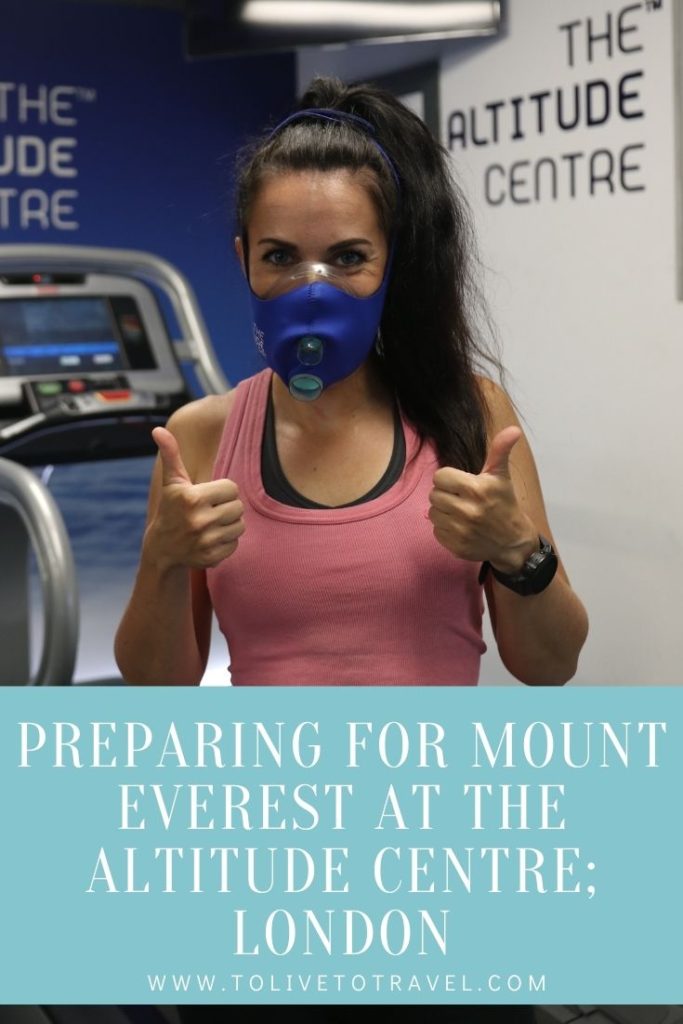As part of my training for Mount Everest, I recently visited the famous Altitude Centre in London, the UK’s number 1 altitude training specialists! They are renowned for their technology and simulated altitude training, which helps both amateurs and professionals meet their acclimatisation, performance or rehabilitation goals. It’s the perfect place for me to learn more about my performance and acclimatisation before my big challenge next year!
Many people use their services before climbing mountains such as Kilimanjaro, Mont Blanc and Elbrus. Even Nirmal “Nims” Purja (he’s climbed all 14 of the 8,000km peaks!) has used the Altitude Centre’s services. He also took along his group who trained for Aconcagua to use their services – so I knew I was in good hands!
The Assessment
My first visit consisted of a Mountaineering Altitude Consultation, a 90-minute assessment which was split into various sections.
The Assessment: Part One
The first section of the assessment consisted of a ‘sitting’ test, where the instructor checked my blood pressure, lung capacity and how my lungs reacted to C02 in a still, sitting position with sea-level oxygen levels.
The instructor firstly checked my blood pressure, which was normal. After this, he tested my heart rate. Although this came back within the ‘normal’ region – it was at the higher-end at 69bpm. However, we recognised that this was probably due to nerves (I was pretty nervous on the way to the consultation!)
Next, we checked my Lung Capacity and for any Lung Obstructions. This was tested by blowing into a tube as fast and as long as possible. My results also came back ‘normal’ and thankfully no Lung Obstructions were found. So far, so good!
Lastly, I had to do a test to check my breath-hold with empty Lungs; which indicated how well my Lungs respond to Carbon Dioxide. This was assessed by simply breathing as-usual, exhaling and resisting inhaling again for as long as possible. I was told to aim for around 20 seconds, yet I was able to hold for 32 seconds, which was great. The longer we’re able to hold our breath with empty Lungs, the better their tolerance is to Carbon Dioxide.
The Assessment: Part Two
During the second part of the assessment, we tested the Oxygen Levels in my body at different simulated altitudes. This was called an ‘AMS Test’ and was conducted by breathing into a machine, which felt as though cold air was blowing into my mouth.
At Sea-level, Oxygen Levels are usually 99% – however, even 95% is still within the norm. Thankfully, mine was 99%.
After 5 minutes at 3,800m, my oxygen levels dropped to 87% and my heart rate increased to 80bpm, however, both were still in the norm.

I then had to repeat this at 5,100m. At this altitude, my oxygen levels lowered to 80%, and my heart rate increased to 90bpm. Once again, still within the norm.
I was told that by breathing through my nose and using my full lungs whilst staying relaxed, that my score would improve. Hypoxic training before going to altitude will also raise this figure.
The Assessment: Part Three
For the next part of the assessment, we moved through to a simulated altitude chamber, with the conditions set to a height of 2,700m (this would be a similar environment to ski-ing and its altitude effects were barely noticeable). For this part of the test, we looked at the effects that exercise had on my body at different altitudes.
I was firstly instructed to walk on a treadmill for 5 minutes at an incline of 12. My oxygen level at this altitude lowered to 90% and my heart rate was around 90bpm also.

I then repeated this, but with the altitude increased to 3,800m (using the machine from the previous test). My heart rate increased to 95bpm and my oxygen lowered to 80%.
Lastly, the altitude was raised to 5,100m, and I had to once again walk for 5 minutes at an incline of 12. I was told that the test would be stopped at either 5 minutes, or if my oxygen level dropped below 75% due to safety precautions. Even though 5 minutes was the aim, the instructor told me that only one person at the altitude centre had ever achieved this, and of course, it was Nims! For added intensity, he was cycling instead of walking and still holds the record!
I managed to reach 4 minutes and 28 seconds, which I was proud of. The results showed that I was able to maintain a high blood oxygen saturation, which suggested my body was able to cope comparatively well with altitude and that I had a below-average susceptibility to AMS (Acute Mountain Sickness). This left me feeling more relaxed and prepared for taking on Everest next April!
The Assessment: Part Four
The last part of the assessment was testing my cognitive ability at altitude. As a general rule, the instructors find that unacclimatised climbers are either able to maintain their physical workload OR their cognitive capacity when climbing at high altitude, but rarely both.
For the test, I had to firstly cycle on a bike for 2 minutes to allow the instructors to find my ‘average’ speed. Following this, i was handed an ipad with a multitude of cognitive ability exercises that i had to complete whilst cycling.

As with the previous tests, I conducted this exercise at an altitude of 2,700m, 3,800m and 5,100m. As the altitude increased, my speed decreased and my answers became less accurate.
However, my competitive nature kicked in as I reached the 5,100m and I made it my prime object to focus! Due to this, I made no mistakes and my accuracy was perfect. However, this did mean that I was much slower at cycling, as well as answering the questions themselves.
Aftercare and Further Training
I truly enjoyed my first training session at the Altitude Centre, and the insights they gave me were invaluable. Moving forwards, I will be returning to the Altitude Centre twice over the next 12 weeks, once at a 6-week halfway point to follow a personalised plan the instructors have created for me, and then at the end to redo the test and hopefully see an improvement!
I was given an in-depth report after my session, with my results and suggestions moving forwards.
Something interesting to note is when training at altitude, the acclimatisation stays in your body for four days following. That means for four days after my training at the Altitude Centre; my body was still acclimatised to those conditions. That’s why you hear famous stories of football teams training at altitude days before a match; their body becomes accustomed to the height, and then when they return to sea-level, everything feels much easier!
When I was climbing Denali in Alaska (the hardest peak I’ve summited so far), our group were walking at a pace of one step every five breathes due to the lack of oxygen and exhaustion. However, as we began to ascend after summiting, our energy increased exponentially, and the group ascended all the way from the highest camp to the base camp in 17 hours, due to the energy we had from the prior acclimatisation.
My Learning from the Session at the Altitude Centre
I learned so much from this first session. It’s given me so much insight on my current abilities and how my body handles acclimatisation. My main takeaways from the session were:
To focus my breathing; breath through my nose and my diaphragm!
To work on increasing my fitness so that my heart rate decreases. At the moment, I am at the higher end of ‘average’, so I want to work on lowering this.
My acclimatisation is better than average, which was great news!

I’d recommend the Altitude Centre to anyone looking to meet their acclimatisation, performance or rehabilitation goals. If you’d like to see more behind-the-scenes action of my first session at the Altitude Centre, you can do so via my Instagram Stories!
Pin for later!



